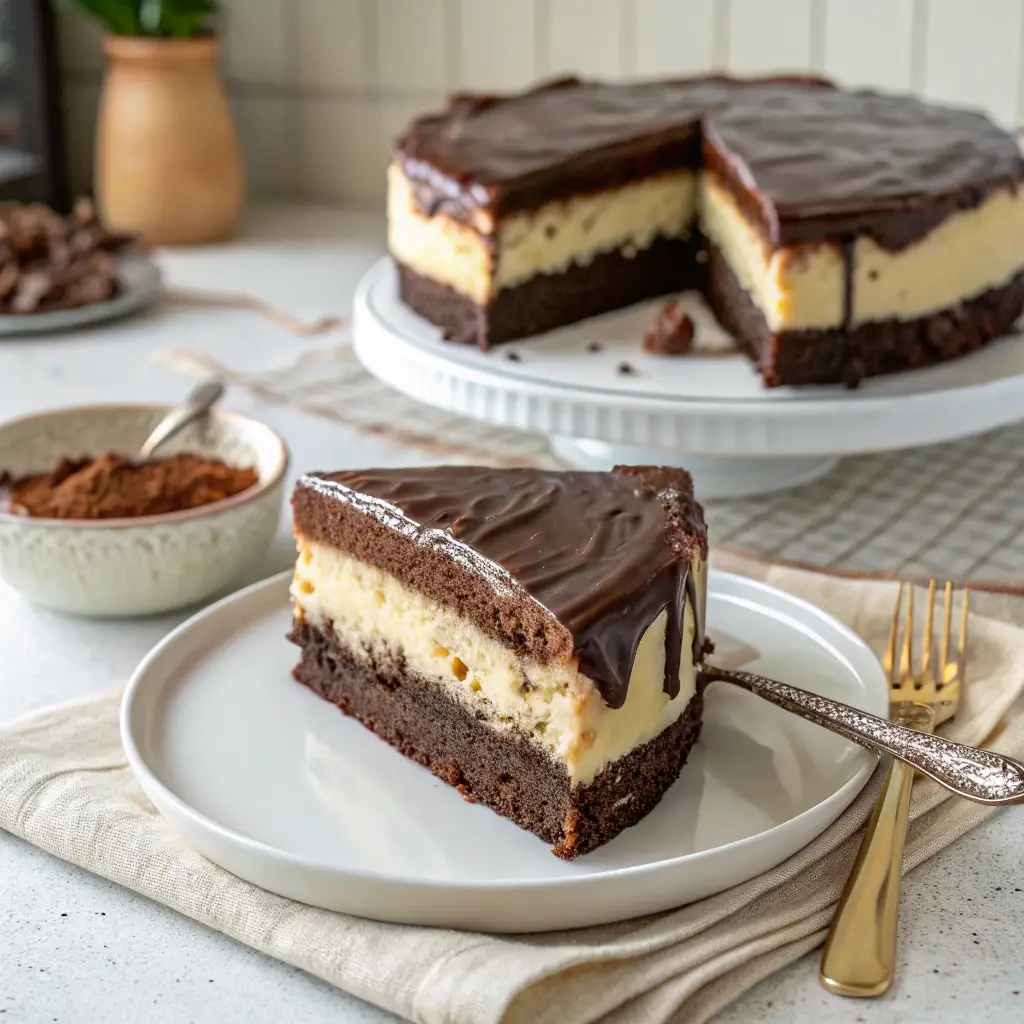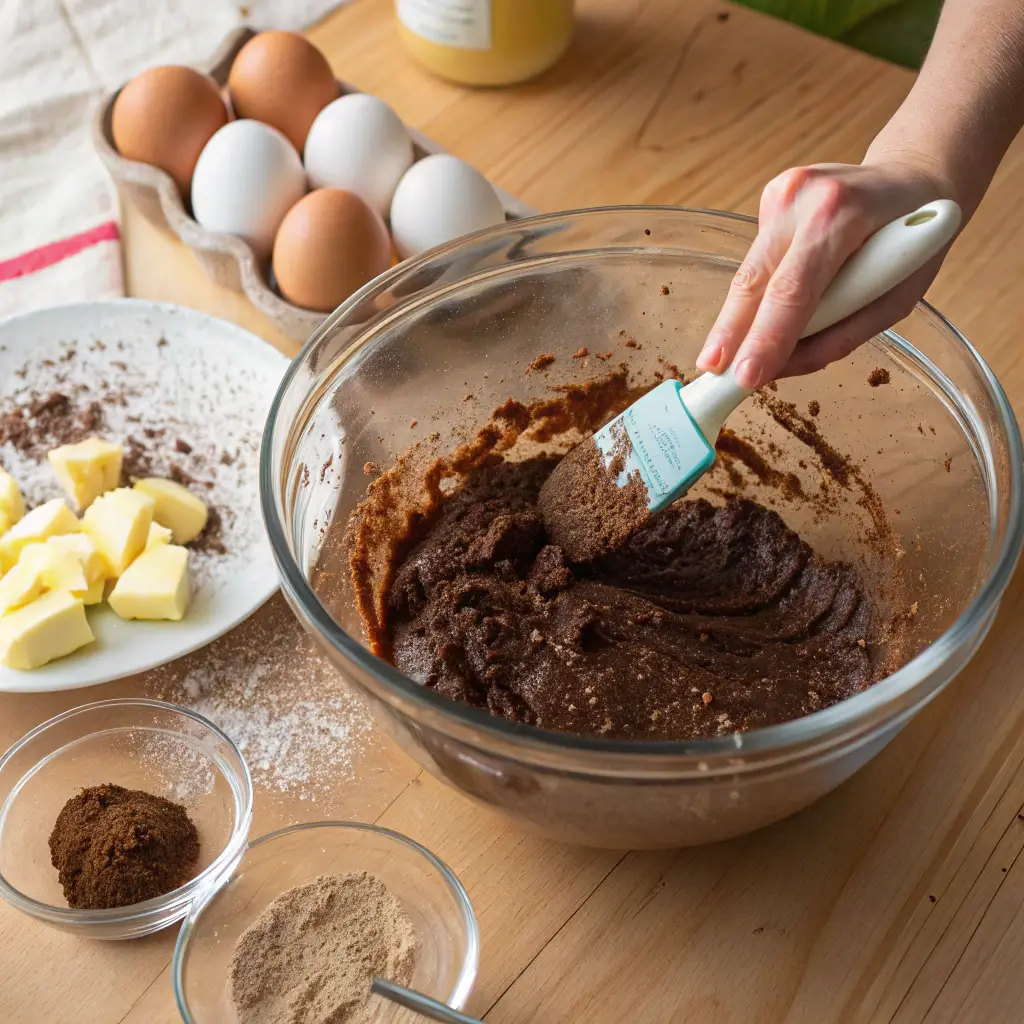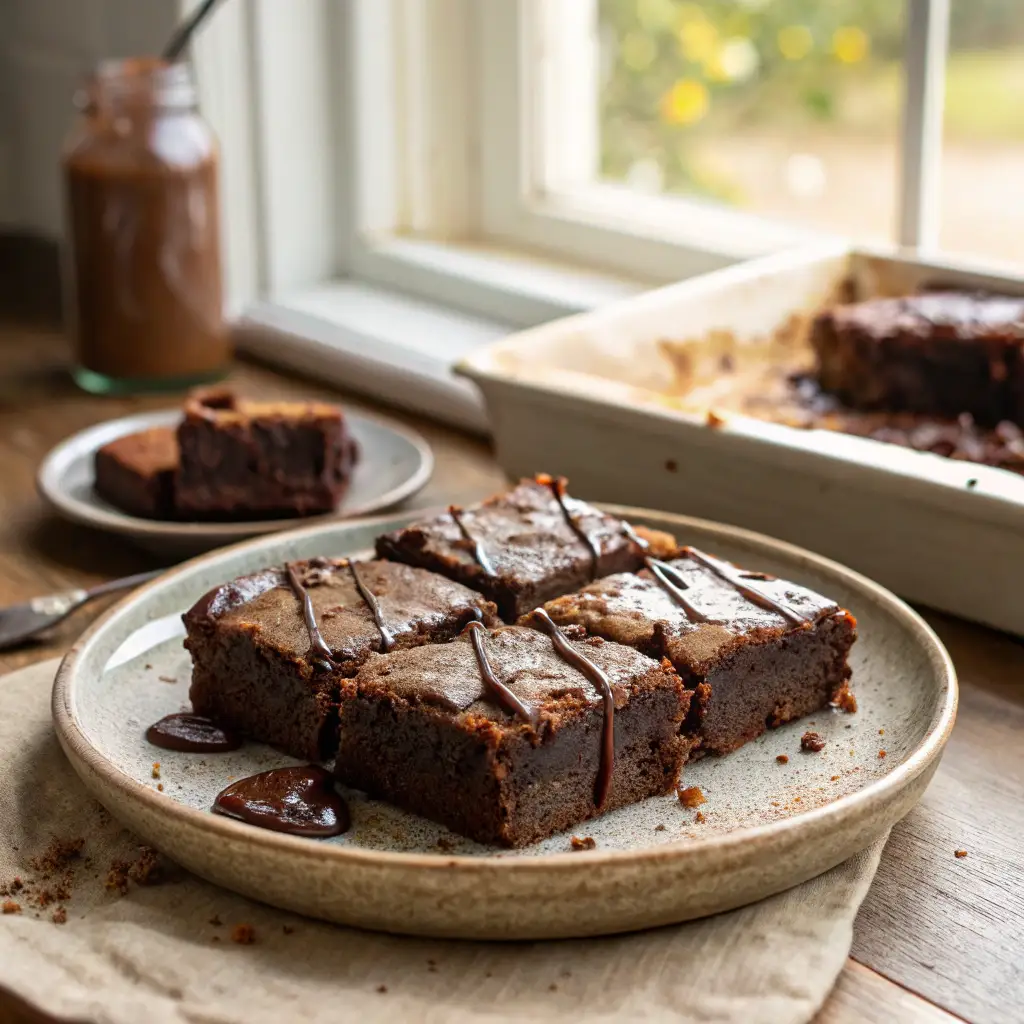If you’ve ever found yourself torn between baking a rich brownie or a fluffy chocolate cake, brownie cake is the answer you didn’t know you needed. This incredible dessert fuses the gooey, chocolaty goodness of brownies with the light texture of cake. Whether you’re a beginner baker or a seasoned home chef, this guide will walk you through everything you need to know—from ingredients and baking tips to creative variations and expert FAQs.
Table of Contents
PART 1: What is a Brownie Cake?
A brownie cake is the glorious hybrid of two beloved desserts—brownies and cake. Combining the fudgy richness of brownies with the lightness of cake, it’s a dream come true for anyone who struggles to choose between the two. Unlike traditional brownies that are chewy and dense, brownie cake boasts a softer crumb while retaining that deep, chocolatey intensity we all crave. It’s like enjoying the best of both worlds—moist like cake, yet rich like brownies.
The origins of brownie cake trace back to modern baker experimentation, where classic boxed brownie mixes began being transformed into layered desserts and even birthday cakes. With just a few tweaks—like adding more eggs or a splash of milk—a simple brownie mix can become a lofty, sliceable masterpiece. Today, brownie cakes are more than just a baking trend; they’re a staple at birthdays, potlucks, and celebrations.
There are various types of brownie cakes depending on the texture and flavor profile you’re after. Some are layered with creamy ganache, others swirled with peanut butter, caramel, or even cheesecake. If you’re after a beginner-friendly version, you can use a store-bought brownie mix as your base and build from there. More adventurous bakers love crafting theirs from scratch, using high-quality cocoa powder or melted dark chocolate for a gourmet flair.
Because it walks the line between two classic desserts, a brownie cake is incredibly versatile. You can frost it like a regular cake, glaze it with chocolate sauce, or top it with powdered sugar and berries for a rustic finish. Whether served warm or chilled, its rich flavor and soft bite make it a crowd-pleaser every single time.
Check out this Strawberry Cheesecake Bars recipe if you’re into rich, layered dessert hybrids.
PART 2: Brownie vs Cake Brownie – What’s the Real Difference?
While they may share a name, brownies, cake brownies, and brownie cake are all distinctly different in texture, ingredients, and baking method. Traditional brownies are dense, chewy, and packed with chocolate. They’re typically made with less flour and more fat—like butter or oil—which creates that rich, moist texture. There’s no need for rising agents like baking powder, and that’s exactly why they don’t puff up like a cake. Brownies are meant to be flat, fudgy, and slightly underbaked in the center.
In contrast, cake brownies aim to combine the chocolatey depth of brownies with the fluffiness of cakes. This means slightly more flour, a bit of baking powder or soda, and perhaps an extra egg or two. The result is a lighter, taller brownie that slices more like a cake but still carries that deep cocoa punch. A brownie cake, however, goes one step further. It adopts the full characteristics of a traditional cake—using standard cake flour ratios, beating methods for fluffiness, and often including frosting or layers.
The key difference lies in their texture. If a brownie is chewy, and a cake brownie is a bit lighter but still dense, then a brownie cake is fully light and airy while retaining the essence of chocolate richness. The baking temperature also varies slightly. While brownies often bake at a lower temperature to avoid overcooking the center, brownie cakes require more precise heat to rise correctly.
You may also notice a difference in serving style. Brownies are cut into squares and eaten by hand. Cake brownies are more flexible—good as bars or slices. But a brownie cake is served in slices, often adorned with toppings or icing, perfect for more formal occasions.
Dutch-processed cocoa gives a smoother, mellow flavor, while natural cocoa offers a tangier, more intense chocolate kick. King Arthur Baking explains it perfectly in their cocoa powder guide, breaking down which to use depending on your recipe goals.
PART 3: Can You Use Brownie Mix for Cake? Yes, Here’s How
If you’ve ever stood in your kitchen wondering whether you can turn a box of brownie mix into a full-on cake, the answer is a resounding yes. While brownie mix is originally designed to produce dense, fudgy squares, it can easily be tweaked to yield a light and fluffy brownie cake—perfect for birthdays, celebrations, or when you just want something chocolatey and tall. The key lies in adjusting the ingredient ratios and mixing method.
To make a brownie cake using boxed mix, you’ll need to make a few changes to the box instructions. First, add an extra egg to help with structure and rise—cakes need more lift than brownies. Replace water with milk for added richness, and consider substituting half the oil with melted butter for better flavor and texture. Want it even fluffier? Mix in a teaspoon of baking powder to encourage the batter to rise more like a classic cake.
Mixing also plays a huge role. While brownies are usually stirred just until combined, cake batter should be beaten slightly longer to incorporate air. Use a hand mixer or stand mixer for a minute or two on medium speed. This little trick can help transform the dense brownie batter into a cake-like consistency.
Whether you use a round cake pan or a rectangular one, remember to line it well and check doneness with a toothpick—around 30–35 minutes at 350°F should do the trick. Once cooled, frost it with chocolate buttercream, drizzle it with ganache, or top with fruit and whipped cream for a stunning finish. The flexibility of boxed brownie mix makes it a great shortcut to homemade brownie cake with very little effort.
PART 4: Ingredients Breakdown – What Goes Into a Brownie Cake?
Crafting the perfect brownie cake starts with understanding the ingredients that give it that unique blend of richness and fluffiness. Whether you’re starting from scratch or modifying a boxed mix, knowing what each component does can help you create a moist, delicious cake every time. At its core, brownie cake includes the essentials of any chocolate dessert—flour, eggs, sugar, fat (like butter or oil), and cocoa powder or melted chocolate. But it’s the ratios and types of these ingredients that make all the difference.
Flour provides the structure, but not too much. Using cake flour or a mix of all-purpose and cornstarch can soften the crumb, giving the cake its signature lift. Cocoa powder—preferably unsweetened—adds that deep chocolatey flavor. Dutch-processed cocoa gives a smoother taste, while natural cocoa offers a slightly tangy, bold chocolate flavor. For extra richness, some recipes call for melted dark chocolate as well.
Fat is crucial. Brownies usually use oil for chewiness, while cakes often rely on butter for a tender, flavorful crumb. For a balanced brownie cake, you can combine both. Eggs help bind everything together and act as leavening agents. Adding an extra egg, especially if using brownie mix, helps achieve a more cake-like texture.
Leavening agents like baking powder or baking soda are often added in small amounts to give the batter a gentle rise. Without them, your brownie cake might stay too flat. For sweetness, granulated sugar is standard, though brown sugar can add moisture and depth.
Want to elevate it? Mix in some semi-sweet chocolate chips, swirl in peanut butter, or fold in chopped nuts. The beauty of brownie cake lies in its versatility. You can even experiment with fillings or layers to make it a true showstopper.
PART 5: Step-by-Step Brownie Cake Baking Instructions
Baking a brownie cake is easier than you think—especially when you follow a structured process. Whether you’re using a box mix or baking from scratch, the goal is to strike the right balance between richness and fluffiness. This section walks you through prepping, baking, and finishing your cake like a pro.
Start by preheating your oven to 350°F. While that warms up, grease your baking pan—an 8×8 square for thicker cake or a 9×13 for thinner slices—and line it with parchment paper. This ensures a smooth release and easy cleanup. If using a box mix, adjust the ingredients as noted earlier: add an extra egg, substitute milk for water, and melt butter in place of oil for added flavor.
In a large bowl, whisk your dry ingredients (if baking from scratch)—flour, cocoa powder, baking powder, and salt. In another, beat your wet ingredients—eggs, sugar, melted butter, and vanilla extract—until creamy. Gradually combine the wet and dry, being careful not to overmix. You want the batter to stay smooth but airy.
Pour the batter evenly into your prepared pan. Bake for 30 to 35 minutes, but start checking around the 28-minute mark. A toothpick inserted in the center should come out with moist crumbs—not wet batter. This ensures your brownie cake is moist but fully cooked.
Let it cool in the pan for 10 minutes, then transfer it to a wire rack to cool completely. Now it’s time to get creative. Drizzle chocolate ganache, add whipped cream, or top with seasonal fruits. No matter how you finish it, following the right baking process ensures your brownie cake turns out soft, rich, and deeply satisfying every time.
PART 6: Brownie Cake Variations and Creative Twists

One of the best things about a brownie cake is how easily it lends itself to fun, flavorful twists. While the classic version is unbeatable, experimenting with layers, swirls, and toppings can elevate your dessert to something truly unforgettable. Whether you’re baking for a holiday, birthday, or just because, these variations add that “wow” factor.
First up is the layered brownie cheesecake cake—a showstopper with a fudgy brownie layer on the bottom, a creamy cheesecake center, and another brownie layer on top. Bake each layer partially before adding the next to maintain structure and definition. Once chilled, top it with ganache or chocolate shavings for a bakery-style finish.
Another favorite is the frosted brownie cake. Once cooled, spread a thick layer of chocolate buttercream or cream cheese frosting over the top. You can also pipe decorative swirls and sprinkle with crushed nuts, mini chocolate chips, or colorful sprinkles to fit the theme.
Want a festive twist? Try a peppermint brownie cake during the holidays. Add peppermint extract to the batter and sprinkle crushed candy canes on top of white chocolate drizzle. For fall, incorporate a swirl of pumpkin puree and cinnamon spice into the batter for a seasonal spin.
Themed variations are also super popular. For a birthday version, layer the cake with vanilla frosting and colorful candy toppings. You can even turn it into a brownie layer cake with two or three stacked cakes, separated by whipped ganache or mousse.
These creative adaptations don’t just look impressive—they also taste incredible. Don’t be afraid to play with ingredients like peanut butter, caramel swirls, or even a hint of espresso powder to intensify the chocolate flavor. With a little imagination, your brownie cake can become your signature dessert.
PART 7: Can I Use Brownie Mix Instead of Cake Mix in a Dump Cake?

Absolutely, you can use brownie mix instead of cake mix in a dump cake, and the result is a rich, gooey twist that elevates the classic recipe. A dump cake traditionally involves layering ingredients—like canned fruit, pudding, or pie filling—into a baking dish and topping them with dry cake mix and butter. The name comes from how you simply “dump” the ingredients into the pan with minimal mixing. When you swap in brownie mix, you get a denser, fudgier dessert with a decadent chocolate base.
To make a brownie cake dump cake, choose your favorite mix—boxed or homemade. Start with a layer of fruit or pie filling (like cherry, raspberry, or even banana slices) in a greased 9×13 pan. Sprinkle the dry brownie mix evenly over the fruit layer. Next, dot the surface with thin slices of butter or drizzle with melted butter to ensure moisture seeps through the brownie layer during baking. If you want to level it up, add chocolate chips, nuts, or shredded coconut before baking.
Bake the dump cake at 350°F for about 40–45 minutes. You’ll know it’s ready when the top is crisp and the filling is bubbling around the edges. The inside will remain soft and gooey—just how a brownie cake should be.
This variation is perfect for when you’re short on time but want to serve something indulgent. It’s also easily adaptable for any occasion. Try a peanut butter and chocolate version by layering peanut butter chips under the mix, or create a s’mores-style version with mini marshmallows on top. Swapping cake mix for brownie mix doesn’t just work—it turns your dump cake into an ooey-gooey crowd favorite.
PART 8: Common Mistakes When Baking a Brownie Cake
Even experienced bakers can run into trouble when making a brownie cake. Unlike straightforward brownies or cake recipes, brownie cakes demand the perfect balance of density and fluff. One wrong move can lead to a dry, dense mess or an undercooked center. But fear not—we’re highlighting the most common baking mistakes and how to avoid them so your brownie cake turns out just right.
Overmixing the batter is one of the biggest missteps. Brownies require gentle stirring, but cake batter benefits from a little air incorporation. The trick for brownie cake is to strike a middle ground—beat the eggs and sugar well for lightness, but once the flour is added, mix just until combined to avoid tough texture.
Another common error is using the wrong pan size or type. A pan that’s too large can dry out the cake, while one that’s too small can leave it underbaked in the center. Stick to the recommended size—usually an 8×8 or 9×13—and use light-colored metal pans for even heat distribution.
Oven temperature matters more than you think. Too hot, and the edges will overbake while the middle stays raw. Use an oven thermometer to ensure a steady 350°F. Always place your pan in the center rack for even cooking. Resist opening the oven door too often, which can cause your brownie cake to collapse.
Also, don’t skip the cooling period. Cutting into your cake too soon can make it fall apart. Let it rest in the pan for 10 minutes, then transfer to a cooling rack.
By avoiding these pitfalls—overbaking, under-mixing, improper pan choices—you’ll create a brownie cake that’s rich, moist, and consistently perfect every time. And once you’ve mastered the basics, the creativity is all yours.
PART 9: Brownie Cake Pairings and Serving Ideas
A rich brownie cake doesn’t need much to shine—but when paired with the right sides or toppings, it can go from great to unforgettable. Whether you’re serving it for a birthday, dinner party, or just a casual weekend treat, the way you present and pair your brownie cake can truly enhance the entire dessert experience.
Let’s start with toppings. A simple dusting of powdered sugar adds a delicate finish and visual appeal. For more indulgence, drizzle warm chocolate ganache or salted caramel sauce over each slice. Want to add a creamy element? A dollop of fresh whipped cream or a swirl of chocolate buttercream frosting does the trick. Frosted brownie cakes are perfect for parties and special occasions, while unfrosted versions work great as after-dinner treats.
Pairing your brownie cake with ice cream is always a hit. Vanilla ice cream complements the deep chocolate flavor, while coffee or raspberry sorbet offers a more gourmet twist. For a crunchy texture contrast, serve your brownie cake with chopped nuts or chocolate curls on top. You can even get creative with fresh berries like strawberries or raspberries, which add brightness to balance out the richness.
When it comes to drinks, milk is the classic choice, but for adults, pair a slice with espresso, red wine, or even a chocolate stout beer for something bold and unexpected.
Presentation also matters. Serve your brownie cake warm with gooey centers slightly melted or chilled for a firmer texture—each offers a different experience. Individual squares, layered slices, or cake wedges? Your call.
Brownie cake isn’t just dessert—it’s a vibe. The right pairings elevate it from a sweet bite to a full sensory event that guests will remember long after the last crumb is gone.
FAQS
What’s the difference between a brownie and a cake brownie?
The main difference lies in the texture and structure. A brownie is chewy, dense, and often rich with minimal rise. A cake brownie, or brownie cake, is lighter and more airy, resembling a traditional cake in height and softness while still carrying that deep chocolate flavor. Cake brownies also usually contain a leavening agent, like baking powder, to give them their lift.
Can you use brownie mix for cake?
Yes! Brownie mix can absolutely be used to make cake, with just a few modifications. Add an extra egg, use milk instead of water, and swap oil for melted butter to achieve a fluffier texture. Adding a bit of baking powder can also help the cake rise better. With these tweaks, your mix will behave more like a traditional cake batter.
What temperature do you bake a brownie cake?
A standard baking temperature for brownie cake is 350°F (175°C). Depending on your oven and pan size, baking can take anywhere from 30 to 45 minutes. Always check for doneness with a toothpick inserted into the center—it should come out with a few moist crumbs but not wet batter.
Can I use brownie mix instead of cake mix in a dump cake?
Definitely. Swapping cake mix for brownie mix in a dump cake adds a rich, fudgy base that complements fruity or creamy layers. Simply layer your filling in the pan, top with dry brownie mix, and dot with butter before baking. It’s an easy, decadent twist on the classic dump cake format.
Conclusion
Whether you’re a chocolate lover, a home baker, or just someone looking for the perfect dessert to impress your guests, the brownie cake delivers on all fronts. It combines the dense, fudgy richness of brownies with the soft, airy texture of a cake, making it one of the most versatile and satisfying desserts you can make. From boxed mix hacks to gourmet variations layered with ganache and cheesecake, the possibilities are endless—and delicious.
By understanding the differences between brownies and cake brownies, tweaking your ingredients, and following simple baking tips, you’ll be well on your way to creating a showstopping dessert that’s easy, adaptable, and always a crowd-pleaser. Whether served warm with a scoop of vanilla ice cream or chilled with a swirl of frosting, brownie cake fits every occasion and craving.
Don’t be afraid to experiment. Add swirls, fold in nuts or chocolate chips, or turn it into a layered masterpiece for holidays and birthdays. With a little creativity, this humble hybrid can become your go-to signature bake.
Looking for your next sweet inspiration? Don’t miss our Strawberry Cheesecake Bars or Mini Chocolate Chip Muffins to round out your dessert table with variety and flavor.
Now, it’s time to preheat that oven, grab your ingredients, and get baking. Your perfect brownie cake awaits.

